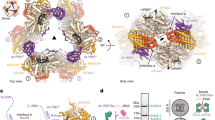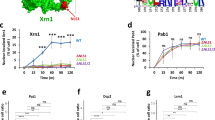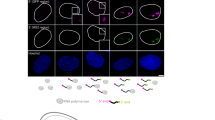Abstract
Nucleophosmin (NPM), an abundant, predominantly nucleolar protein that influences numerous cellular processes, was shown to specifically associate with the bodies of messenger RNAs as a result of the process of 3′-end formation. NPM deposition requires polyadenylation but not the 3′ cleavage event to occur on the transcript. Furthermore, the protein does not associate with RNAs bearing a preformed poly(A) tail or with mRNAs that have undergone cleavage but not polyadenylation. A region within 10 bases upstream of the AAUAAA element is required for NPM association, but deposition of the protein seems to be sequence independent. NPM association with poly(A)+ mRNAs was also demonstrated in vivo. NPM, therefore, represents a mark left on transcripts as a result of 3′-end processing and may have a role in one or more of a variety of post-transcriptional processes influenced by the polyadenylation event.
This is a preview of subscription content, access via your institution
Access options
Subscribe to this journal
Receive 12 print issues and online access
$189.00 per year
only $15.75 per issue
Buy this article
- Purchase on Springer Link
- Instant access to full article PDF
Prices may be subject to local taxes which are calculated during checkout






Similar content being viewed by others
References
Fasken, M.B. & Corbett, A.H. Process or perish: quality control in mRNA biogenesis. Nat. Struct. Mol. Biol. 12, 482–488 (2005).
Bentley, D.L. Rules of engagement: co-transcriptional recruitment of pre-mRNA processing factors. Curr. Opin. Cell Biol. 17, 251–256 (2005).
Shatkin, A.J. & Manley, J.L. The ends of the affair: capping and polyadenylation. Nat. Struct. Biol. 7, 838–842 (2000).
Gornemann, J., Kotovic, K.M., Hujer, K. & Neugebauer, K.M. Cotranscriptional spliceosome assembly occurs in a stepwise fashion and requires the cap binding complex. Mol. Cell 19, 53–63 (2005).
Zorio, D.A. & Bentley, D.L. The link between mRNA processing and transcription: communication works both ways. Exp. Cell Res. 296, 91–97 (2004).
Rodriguez, M.S., Dargemont, C. & Stutz, F. Nuclear export of RNA. Biol. Cell. 96, 639–655 (2004).
Huang, Y. & Steitz, J.A. SRprises along a messenger's journey. Mol. Cell 17, 613–615 (2005).
Tange, T.O., Nott, A. & Moore, M.J. The ever-increasing complexities of the exon junction complex. Curr. Opin. Cell Biol. 16, 279–284 (2004).
Lejeune, F. & Maquat, L.E. Mechanistic links between nonsense-mediated mRNA decay and pre-mRNA splicing in mammalian cells. Curr. Opin. Cell Biol. 17, 309–315 (2005).
Wiegand, H.L., Lu, S. & Cullen, B.R. Exon junction complexes mediate the enhancing effect of splicing on mRNA expression. Proc. Natl. Acad. Sci. USA 100, 11327–11332 (2003).
Nott, A., Le, H.H. & Moore, M.J. Splicing enhances translation in mammalian cells: an additional function of the exon junction complex. Genes Dev. 18, 210–222 (2004).
Lykke-Andersen, J., Shu, M.D. & Steitz, J.A. Communication of the position of exon-exon junctions to the mRNA surveillance machinery by the protein RNPS1. Science 293, 1836–1839 (2001).
Kahvejian, A., Svitkin, Y.V., Sukarieh, R., M'Boutchou, M.N. & Sonenberg, N. Mammalian poly(A)-binding protein is a eukaryotic translation initiation factor, which acts via multiple mechanisms. Genes Dev. 19, 104–113 (2005).
Dunn, E.F., Hammell, C.M., Hodge, C.A. & Cole, C.N. Yeast poly(A)-binding protein, Pab1, and PAN, a poly(A) nuclease complex recruited by Pab1, connect mRNA biogenesis to export. Genes Dev. 19, 90–103 (2005).
Huang, Y. & Carmichael, G.C. Role of polyadenylation in nucleocytoplasmic transport of mRNA. Mol. Cell. Biol. 16, 1534–1542 (1996).
Moore, C.L. & Sharp, P.A. Accurate cleavage and polyadenylation of exogenous RNA substrate. Cell 41, 845–855 (1985).
Murthy, K.G. & Manley, J.L. The 160-kD subunit of human cleavage-polyadenylation specificity factor coordinates pre-mRNA 3′-end formation. Genes Dev. 9, 2672–2683 (1995).
MacDonald, C.C., Wilusz, J. & Shenk, T. The 64-kilodalton subunit of the CstF polyadenylation factor binds to pre-mRNAs downstream of the cleavage site and influences cleavage site location. Mol. Cell. Biol. 14, 6647–6654 (1994).
Chen, F., MacDonald, C.C. & Wilusz, J. Cleavage site determinants in the mammalian polyadenylation signal. Nucleic Acids Res. 23, 2614–2620 (1995).
Kuhn, U. & Wahle, E. Structure and function of poly(A) binding proteins. Biochim. Biophys. Acta 1678, 67–84 (2004).
Wilusz, J. & Shenk, T. A 64 kd nuclear protein binds to RNA segments that include the AAUAAA polyadenylation motif. Cell 52, 221–228 (1988).
Chan, W.Y. et al. Characterization of the cDNA encoding human nucleophosmin and studies of its role in normal and abnormal growth. Biochemistry 28, 1033–1039 (1989).
Zarkower, D., Stephenson, P., Sheets, M. & Wickens, M. The AAUAAA sequence is required both for cleavage and for polyadenylation of simian virus 40 pre-mRNA in vitro. Mol. Cell. Biol. 6, 2317–2323 (1986).
Bagga, P.S., Arhin, G.K. & Wilusz, J. DSEF-1 is a member of the hnRNP H family of RNA-binding proteins and stimulates pre-mRNA cleavage and polyadenylation in vitro. Nucleic Acids Res. 26, 5343–5350 (1998).
Wigley, P.L., Sheets, M.D., Zarkower, D.A., Whitmer, M.E. & Wickens, M. Polyadenylation of mRNA: minimal substrates and a requirement for the 2′ hydroxyl of the U in AAUAAA. Mol. Cell. Biol. 10, 1705–1713 (1990).
Dergunova, N.N. et al. A major nucleolar protein B23 as a marker of proliferation activity of human peripheral lymphocytes. Immunol. Lett. 83, 67–72 (2002).
Schmidt-Zachmann, M.S., Hugle-Dorr, B. & Franke, W.W. A constitutive nucleolar protein identified as a member of the nucleoplasmin family. EMBO J. 6, 1881–1890 (1987).
Zhang, Y. The ARF-B23 connection: implications for growth control and cancer treatment. Cell Cycle 3, 259–262 (2004).
Dhar, S.K., Lynn, B.C., Daosukho, C. & St. Clair, D.K. Identification of nucleophosmin as an NF-kappaB co-activator for the induction of the human SOD2 gene. J. Biol. Chem. 279, 28209–28219 (2004).
Grisendi, S. et al. Role of nucleophosmin in embryonic development and tumorigenesis. Nature 437, 147–153 (2005).
Okuwaki, M., Matsumoto, K., Tsujimoto, M. & Nagata, K. Function of nucleophosmin/B23, a nucleolar acidic protein, as a histone chaperone. FEBS Lett. 506, 272–276 (2001).
Szebeni, A., Herrera, J.E. & Olson, M.O. Interaction of nucleolar protein B23 with peptides related to nuclear localization signals. Biochemistry 34, 8037–8042 (1995).
Latonen, L. & Laiho, M. Cellular UV damage responses-functions of tumor suppressor p53. Biochim. Biophys. Acta 1755, 71–89 (2005).
Ahn, J.Y. et al. Nucleophosmin/B23, a nuclear PI(3,4,5)P(3) receptor, mediates the antiapoptotic actions of NGF by inhibiting CAD. Mol. Cell 18, 435–445 (2005).
Nakagawa, M., Kameoka, Y. & Suzuki, R. Nucleophosmin in acute myelogenous leukemia. N. Engl. J. Med. 352, 1819–1820 (2005).
Colombo, E., Marine, J.C., Danovi, D., Falini, B. & Pelicci, P.G. Nucleophosmin regulates the stability and transcriptional activity of p53. Nat. Cell Biol. 4, 529–533 (2002).
Sato, K. et al. Nucleophosmin/B23 is a candidate substrate for the BRCA1-BARD1 ubiquitin ligase. J. Biol. Chem. 279, 30919–30922 (2004).
Kleiman, F.E. & Manley, J.L. Functional interaction of BRCA1-associated BARD1 with polyadenylation factor CstF-50. Science 285, 1576–1579 (1999).
Kleiman, F.E. & Manley, J.L. The BARD1-CstF-50 interaction links mRNA 3′ end formation to DNA damage and tumor suppression. Cell 104, 743–753 (2001).
Kleiman, F.E. et al. BRCA1/BARD1 inhibition of mRNA 3′ processing involves targeted degradation of RNA polymerase II. Genes Dev. 19, 1227–1237 (2005).
Andersen, J.S. et al. Directed proteomic analysis of the human nucleolus. Curr. Biol. 12, 1–11 (2002).
Scherl, A. et al. Functional proteomic analysis of human nucleolus. Mol. Biol. Cell 13, 4100–4109 (2002).
Pendle, A.F. et al. Proteomic analysis of the Arabidopsis nucleolus suggests novel nucleolar functions. Mol. Biol. Cell 16, 260–269 (2005).
Ideue, T. et al. The nucleolus is involved in mRNA export from the nucleus in fission yeast. J. Cell Sci. 117, 2887–2895 (2004).
Szebeni, A. et al. Nucleolar protein B23 stimulates nuclear import of the HIV-1 Rev protein and NLS-conjugated albumin. Biochemistry 36, 3941–3949 (1997).
Fankhauser, C., Izaurralde, E., Adachi, Y., Wingfield, P. & Laemmli, U.K. Specific complex of human immunodeficiency virus type 1 rev and nucleolar B23 proteins: dissociation by the Rev response element. Mol. Cell. Biol. 11, 2567–2575 (1991).
Chan, H.J., Weng, J.J. & Yung, B.Y. Nucleophosmin/B23-binding peptide inhibits tumor growth and up-regulates transcriptional activity of p53. Biochem. Biophys. Res. Commun. 333, 396–403 (2005).
Wang, W., Budhu, A., Forgues, M. & Wang, X.W. Temporal and spatial control of nucleophosmin by the Ran-Crm1 complex in centrosome duplication. Nat. Cell Biol. 7, 823–830 (2005).
Li, Y.P., Busch, R.K., Valdez, B.C. & Busch, H. C23 interacts with B23, a putative nucleolar-localization-signal-binding protein. Eur. J. Biochem. 237, 153–158 (1996).
Chen, C.Y. et al. Nucleolin and YB-1 are required for JNK-mediated interleukin-2 mRNA stabilization during T-cell activation. Genes Dev. 14, 1236–1248 (2000).
Liu, X. & Mertz, J.E. HnRNP L binds a cis-acting RNA sequence element that enables intron-dependent gene expression. Genes Dev. 9, 1766–1780 (1995).
Huang, Y., Wimler, K.M. & Carmichael, G.G. Intronless mRNA transport elements may affect multiple steps of pre-mRNA processing. EMBO J. 18, 1642–1652 (1999).
Lee, S.Y. et al. A proteomics approach for the identification of nucleophosmin and heterogeneous nuclear ribonucleoprotein C1/C2 as chromatin-binding proteins in response to DNA double-strand breaks. Biochem. J. 388, 7–15 (2005).
Proudfoot, N. New perspectives on connecting messenger RNA 3′ end formation to transcription. Curr. Opin. Cell Biol. 16, 272–278 (2004).
Minvielle-Sebastia, L. & Keller, W. mRNA polyadenylation and its coupling to other RNA processing reactions and to transcription. Curr. Opin. Cell Biol. 11, 352–357 (1999).
Mayeda, A. et al. Purification and characterization of human RNPS1: a general activator of pre-mRNA splicing. EMBO J. 18, 4560–4570 (1999).
Tarapore, P. et al. Thr(199) phosphorylation targets nucleophosmin to nuclear speckles and represses pre-mRNA processing. FEBS Lett. 580, 399–409 (2006).
Dignam, J.D., Lebovitz, R.M. & Roeder, R.G. Accurate transcription initiation by RNA polymerase II in a soluble extract from isolated mammalian nuclei. Nucleic Acids Res. 11, 1475–1489 (1983).
Dreyfuss, G., Choi, Y.D. & Adam, S.A. Characterization of heterogeneous nuclear RNA-protein complexes in vivo with monoclonal antibodies. Mol. Cell. Biol. 4, 1104–1114 (1984).
Qian, Z. & Wilusz, J. GRSF-1: a poly(A)+ mRNA binding protein which interacts with a conserved G-rich element. Nucleic Acids Res. 22, 2334–2343 (1994).
Acknowledgements
This work was supported by US National Institutes of Health grant GM072481 to J.W.
Author information
Authors and Affiliations
Corresponding author
Ethics declarations
Competing interests
The authors declare no competing financial interests.
Rights and permissions
About this article
Cite this article
Palaniswamy, V., Moraes, K., Wilusz, C. et al. Nucleophosmin is selectively deposited on mRNA during polyadenylation. Nat Struct Mol Biol 13, 429–435 (2006). https://doi.org/10.1038/nsmb1080
Received:
Accepted:
Published:
Issue Date:
DOI: https://doi.org/10.1038/nsmb1080
This article is cited by
-
Nucleophosmin deposition during mRNA 3′ end processing influences poly(A) tail length
The EMBO Journal (2011)
-
Nucleophosmin and its complex network: a possible therapeutic target in hematological diseases
Oncogene (2011)
-
Chromatin: linking structure and function in the nucleolus
Chromosoma (2009)
-
Oncogenes and tumour suppressors take on centrosomes
Nature Reviews Cancer (2007)
-
Fusion of FIP1L1 and RARA as a result of a novel t(4;17)(q12;q21) in a case of juvenile myelomonocytic leukemia
Leukemia (2007)



